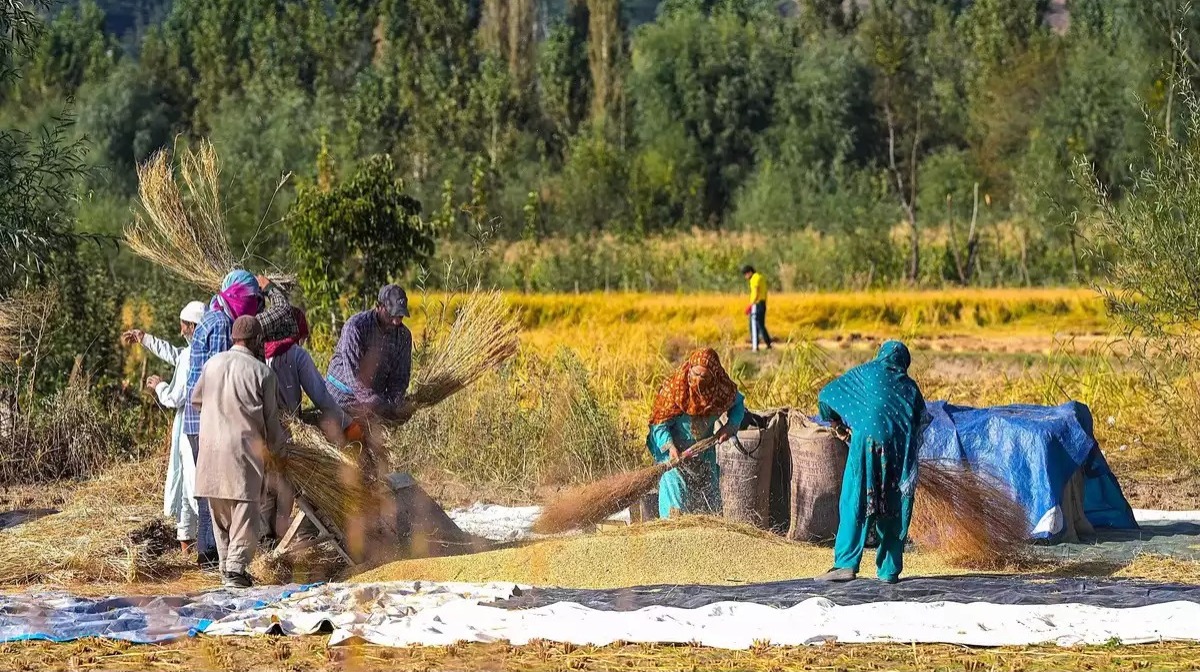Synopsis
The cultivation area of the indigenous aromatic rice variety, Mushk Budji, from Kashmir is set to expand to 5,000 hectares in the next three years. This variety of rice was on the verge of extinction due to disease susceptibility and poor yield potential. However, efforts by the agriculture department and Sher-e-Kashmir University of Agricultural Sciences and Technology (SKUAST) have led to its revival. The aim is to transform the agriculture economy in Jammu and Kashmir, boost exports, and improve farmer prosperity. The rice has received a Geographical Indication (GI) tag and is expected to tap into national and international markets.
Mushk Budji — the indigenous aromatic rice variety from Kashmir — is likely to get a major boost in its yield with the Jammu and Kashmir authorities planning to expand its cultivation area to 5,000 hectares in the next three years, a senior official has said. According to experts at the Sher-e-Kashmir University of Agricultural Sciences and Technology (SKUAST), this high-cost traditional variety of rice was on the verge of extinction and was pushed to a few pockets of the Valley because of its susceptibility to blast disease.
Besides, non-uniformity in the produce, lack of quality seed, poor yield potential due to the mixing of strains and also due to area expansion under high-yielding paddy varieties led to shrinking of acreage under it, they said.
Mushk Budji, mostly grown on over 250 hectares in five villages of Kokernag in south Kashmir, received a Geographical Indication (GI) tag in August due to the concerted efforts by the agriculture department and SKUAST.
“The niche crop is grown in particular climatic conditions and we are exploring various areas in different parts of the Valley to expand its acreage.
“We aim to bring 5,000 hectares of land under crop cultivation in the next three years under the holistic development of agriculture and allied sectors scheme,” Chowdhary Mohammad Iqbal, the director of the Department of Agriculture Production and Farmers Welfare, Kashmir, told PTI.
Last year, Jammu and Kashmir Lieutenant Governor Manoj Sinha approved the Holistic Development of Agriculture and Allied Sectors programme, with an outlay of Rs 5,013 crore over the next five years and covering 29 projects.
The aim is to transform the agriculture economy and put Jammu and Kashmir on a new trajectory of growth, boosting exports and heralding a new phase of farmer prosperity and rural livelihood security in the Union territory.
“We have been successful in expanding the Mushk Budji to Budgam and are expecting more farmers to grow the crop, leading to its increased production to meet the growing demand,” Iqbal said.
According to the experts, as part of the programme to revive the cultivation of Mushk Budji, Sagam and adjoining villages in Kokernag in Anantnag district were identified in 2013.

Officials said the success of Mushk Budji in Anantnag led to a variety of testing programmes in non-traditional areas under similar ecologies. The agriculture department with the help of SKUAST-Kashmir brought in a new variety of Mushk Budji seeds.
“The new seed is resistant to diseases and changing climatic conditions. With the setting up of farmers producers organization, we are endeavouring to make Mushk Budji tap the national and international markets,” Chowdhary Mohammad Iqbal said.
Referring to the week-long ‘GI Mohatsav’ which started at ‘Kashmir Haat’ in Srinagar on October 2, he said 100 GI-tagged agriculture and horticulture products both within and outside Jammu and Kashmir are on display.
Attending the event, Manzoor Ahmad Bhat from Sagam village of Kokernag said over 500 farmers from nearly half a dozen villages are growing Musk Budji and will benefit immensely from the GI tagging of their produce.
“We are selling one kg Mushk Budji for Rs 260 and have received a lot of response in Srinagar. We have also received calls from Dubai for the product,” he said.
In Sagam village, Ghulam Mohammad, an elderly farmer, said they stopped growing the crop a long time ago and started afresh sometime back with the government’s support.
Read more at-https://shorturl.at/nvwR5



